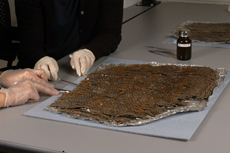|
Conservation
When the basketry artifacts were first excavated, a method of preservation was needed to keep the objects from crumbling and disintegrating once they were removed from their protective layers of wet mud. Several methods were tried, like beeswax and benzine. After these failed, a solution of water and polyvinyl acetate (PVA), commonly known as Elmer's Glue®, was used to coat each fragment of basketry. This solution caused the baskets to stick to the foil they were stored on, and to become very brittle. When the Biderbost basketry was donated to the Burke, the collection was in need of re-housing and conservation treatment. The basketry artifacts were housed using a variety of non-archival methods. Many basketry fragments were adhered to foil and placed on cardboard trays or boxes, some were stored in acidic cardboard boxes wrapped in plastic, and some were placed on cotton batting in artifact display boxes with glass tops. It was evident that these fragile artifacts needed to be removed from their foil backing and housed in specially made acid-free boxes. Conservator Dana Senge examined the basketry to determine a treatment to remove the baskets stuck to foil. The treatment involves using cotton swabs dipped in ethyl alcohol to dissolve the glue from the basket so that it can then be gently removed from the foil. Students in the Museology Program performed this treatment on a few fragments. Some fragments still need conservation treatment. The Archaeology Department has set up the Adopt-a-Basket program where individuals can choose a basketry fragment and donate funds to have it conserved and re-housed. |
UW Museology students perform conservation treatment on a checker plaited basketry fragment
Video by Kyle Jones

UW Museology students perform conservation treatment on Biderbost basketry
Photograph by Burke Museum
|

